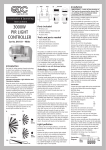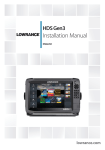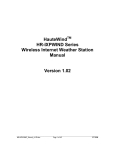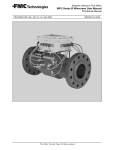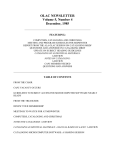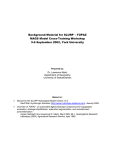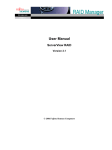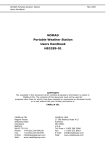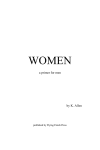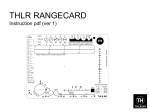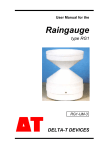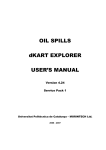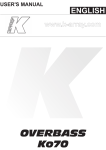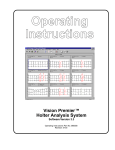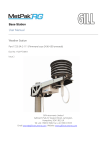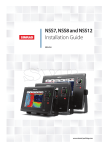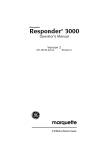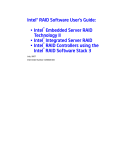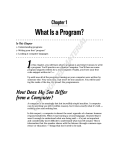Download A Guide for Amateur Observers to the Exposure and Calibration of
Transcript
A Guide to the Siting, Exposure and Calibration of Automatic Weather Stations for Synoptic and Climatological Observations By Andrew K. Overton © Andrew K. Overton 2009 1 Contents Introduction......................................................................................................................................... 3 Siting and Exposure.................................................. ......................................................................... 3-7 Temperature and relative humidity......................................................................................... 4, 5 Precipitation............................................................................................................................ 5, 6 Wind speed and direction........................................................................................................ 6, 7 Sunshine, solar & UV radiation............................................................................................... 7 Calibration........................................................................................................................................... 7-15 Pressure................................................................................................................................... 9 Air temperature....................................................................................................................... 10 Grass minimum and soil temperature..................................................................................... 10 Relative humidity.................................................................................................................... 11 Precipitation............................................................................................................................ 11-14 Wind speed and direction........................................................................................................ 14 Solar/UV radiation and sunshine............................................................................................. 15 Cumulative Rounding Errors............................................................................................................... 15, 16 Metadata............................................................................................................................................... 16, 17 Data Archiving..................................................................................................................................... 17-19 Resources............................................................................................................................................. 19 Acknowledgements.............................................................................................................................. 19, 20 References............................................................................................................................................ 20 Index.....................................................................................................................................................21 Version 3.1 The copyright of this document rests with the author. 2 Introduction Automatic Weather Stations (AWS) are becoming increasingly popular in many applications owing to their becoming more affordable, reliable, having improved datalogging capabilities and through the growth in personal computing bringing sophisticated data manipulation and archiving within the reach of all. This guide is of relevance to all who manage AWS, but it is primarily aimed at the amateur observer who cannot be tied to a station at 0900 UT due to the requirements of employment and family life, and brings the opportunity to contribute data recorded between the standard climatological times. AWS have the potential to add enormously to the historical weather data in the UK by recording in fine detail meteorological parameters from a wide range and great number of sites. However, they also have the potential to set meteorology back many decades if poorly sited and poorly calibrated. These two factors are well recognised as fundamental when dealing with traditional instruments but AWS bring new challenges. Although the principles of traditional instruments apply equally to AWS, often the practicalities brought on by the design of equipment mean that compromises are unavoidable and calibration of sensors more difficult. Too often the precision of AWS sensors is mistaken for apparent accuracy. Accurate many of them have the potential to become, but only with careful exposure and calibration - very few are acceptably accurate 'out of the box'; competitive price restraints on manufacturers prevent the individual calibration to be found on professional grade instruments. However, with careful consideration of exposure prior to installation, and initial and ongoing calibration of sensors, many models of amateur quality AWS can give equipment many times their price a run for their money. Without this application, though, data cannot be relied upon - poor exposure often invalidates it and lack of calibration casts doubt on its accuracy. Many papers and books have been produced which deal with the application of standard exposure and calibration techniques to AWS but these generally assume access to expensive professional facilities, sites and equipment. These are not available to the amateur, generally operating from a suburban back garden site with only the facilities and equipment affordable by the average person. What this guide sets out to do is to condense the techniques used by the professional and apply them to the amateur environment. Compromises in exposure are generally inevitable and calibration sometimes rough and ready but any effort is better than none at all. A cheap temperature sensor calibrated to no better than ±1 °C is a known quantity and its data can be used with confidence; an expensive one uncalibrated is almost useless. By making the best effort possible (and recording with the data the limitations of exposure and calibration) the amateur gives confidence to those using the data accumulated, who can allow for possible errors and apply corrections where appropriate. Buying an AWS and getting it to work is just the first step on the road to producing climatological and meteorological data which will hopefully be not only interesting in itself but also a future asset to the meteorological community. Siting, exposure and calibration are the essential next stages. Siting and Exposure The issues of siting and exposure are concerned with ensuring that everyone is recording the same thing, the same way, with the same limitations to allow intercomparison of data. Without some minimum standards of site and exposure it is difficult, if not impossible, to compare one station's data with another as it is specific in nature to the station recording it and can only serve to show changes and variations there. Siting refers to the physical characteristics of the recording location whilst exposure refers to the deployment of the instruments in relation to the elements. When air temperatures are quoted, for example, these apply to measurements taken in accordance with agreed standards of siting and exposure. Should a station which is operating with 3 instruments sited and exposed at variance with these standards attempt any direct comparison of data with another, this is likely to be a difficult exercise. Values of air temperature, in common with most other variables, show marked differences in value at different locations within even the same site, depending on the height at which the observations are taken and their proximity to other objects. Standard siting and exposure of instruments is therefore the bedrock of the entire observing process: neglect these matters and data become much less useful to the wider community. However, before observers with limited sites despair of producing useful data, it should be pointed out that where ideal positioning is not possible and compromise is inevitable, provided detailed notes are kept with the data to indicate the siting and exposure achieved (metadata) the data still has considerable value, as sometimes allowances can be made for limited exposure, etc.. The standard siting and exposures for the different types of recording instrument can be found in The Observer's Handbook, published by The Met Office. If you can meet the criteria within for your own equipment, congratulations! Yours will be very well exposed instruments with your data extremely valuable and you are unlikely to find much of value in the Siting and Exposure section of this guide. These standards are always the ideal to be sought and advice in this Guide is based on these. For those unable to meet the ideal, the following details should allow a good compromise siting. It is to be noted, though, that many AWS have sensors bundled together, e.g. raingauge integral with sensor screen, and the perfect siting and exposure being found for one of these components may mean that the other is poorly sited and/ or exposed. Often it is necessary to choose a location which is ideal for none of them but which provides the best overall compromise. It is sometimes better to have two components moderately well sited / exposed than to have one perfectly well and the other appallingly badly sited / exposed. However, when considering this option judgement must be exercised to ensure that the compromise does not result in the data from one variable being almost useless without considerable manipulation. For example, it would not be a good idea to mount an integral thermometer screen/ raingauge 50 cm above ground level in order to get the latter closer to the ideal height. This would result in recorded temperatures being impossible to compare with other sites without considerable corrections, which would at best only produce approximations. In this case, it is better to accept the undercatch on the raingauge as it will in any case provide a record of the actual occurrence of rain and times., and use another raingauge at a ‘standard’ height to provide the ‘climatological rainfall total’. Temperature and Relative Humidity Air temperature and humidity should be measured at between 1 and 1.5 metres (approximately 4 feet) above the ground in a shaded and ventilated environment; such an environment is usually provided by a whitepainted Stevenson Screen, which acts to keep the temperature sensor out of the warming effects of direct or indirect solar radiation, infrared radiation from all objects in sight, and rain but permits free air flow around the sensor . Ideally the temperature sensors should be positioned in a Stevenson Screen at this height but this is often impossible with makes of AWS which have the raingauge attached to the sensor screen. The problem with relying on the AWS screen is that there are varying patterns, each with their own exposure, and with widely varying responses to solar radiation, wind flow, rainfall etc. The Stevenson Screen has been the standard exposure in the UK and many other countries for over 120 years and, while not perfect in every respect, does provide a benchmark reference by which readings can be compared, not only between stations, but over a long period of climatological record. [Note: Internationally there are many variations in the design and deployment height of Stevenson Screens.] Extensive trials of AWS screens alongside Stevenson Screens to compare exposures have shown differences, and these are to be expected; slavishly attempting to copy one exposure and type of instrument (e.g. mercury-in-glass thermometers in a Stevenson Screen with a fastreacting thermistor in a small plastic screen of much lower thermal mass) will produce only confusion and frustration. It is more likely than not that smaller plastic screens containing thermistors will increasingly be accepted as the standard in the coming decade, but for now the wide variety of screens and systems and 4 fragmentation of standards is more likely than not to introduce doubt about recorded values. During days of high insolation with little wind in summer the small plastic screens provided with AWS can cause an overreading of temperature of 1-2°C compared with Stevenson screens, although well-designed naturally aspirated screens, as well as fan aspirated screens, can greatly reduce this difference. Some screens can even be shown to be cooler than the Stevenson Screen under such conditions; any error in such conditions is likely to be above the true air temperature rather than below. Ideally, the screen should be fixed in an open place with good airflow on a level surface above short grass at the standard height. It should be no nearer than 30 metres (100 feet) from extensive concrete, aggregate or a road surface. Measure the height of surrounding objects above screen level: the distance from the screen to these objects should be at least two times these heights. These are the ideals but what of the amateur siting his equipment in a suburban garden? There may be trees in the garden and if it is possible to move the screen far enough away from them it approaches too closely to the walls of the house, garden fence or hedging, or even off the lawn and into the herbaceous border. This is a typical problem and no hard and fast rules can be laid down but an assessment of the various obstructions is necessary to enable a decision to be made over which object will be least detrimental to approach too closely. For example, moving the screen too close to a south facing brick wall to get it away from a north facing privet would not be the correct compromise due to the greater heat radiated by the wall as opposed to the reduced airflow and increased transpiration near the hedge. From the above it should be obvious that the siting of screens and sensors on the eaves of the house is totally unacceptable as it will give largely meaningless results, except in windy weather; as is fixing it to the post of a wooden-panelled garden fence, although all of these transgressions have been observed. Grass minimum temperatures should be measured, as implied, above a grass surface, not soil or other ground cover, unless this is more representative of the locality. Sensors used to measure grass minimum temperature should be of an appropriate design with minimum thermal bulk and good weather-resistance, as these sensors will experience a very wide range of temperatures over a full year and will also be exposed to rainfall, snowfall etc; not many battery-powered wireless sensors will operate reliably for long under such conditions. The same conditions regarding surrounding objects and siting in respect of screens apply equally to grass minimum temperature sensors, and any overhead or near-overhead obstructions, no matter how apparently insignificant, such as a nearby tall hedge or tree branches, can affect the readings . The grass should be kept short and the temperature sensor fixed so as to be level with the tips of the blades. During periods of lying snow it will be necessary to raise the sensor so as to have it positioned on the snow surface. Soil temperatures (down to 20-25 cm depth) should be measured in an area of open soil representative of that naturally occurring at the site. Earth temperatures (at 30 cm or below) should be measured beneath a ground cover of short grass. The temperature sensors should be positioned at the required depths and once again should be suitable for the environment in which they are placed; sealed, cabled sensors suitable for burial are essential for an environment which may be waterlogged for several months of the year. Precipitation Ideally, the rim of the raingauge should be sited at 30 cm above ground level. Precipitation catch varies with height due to turbulent eddies and there is considerable reduction in catch as wind speed increases above the ground. Severely elevated mountings are also objectionable due to the difficulties with maintenance. Gauges need regular cleaning to remove silt deposits from tipping buckets and bird droppings. The higher the gauge is mounted, the more attractive it becomes as a perch and the more cleaning required. Surrounding 5 objects also affect airflow and provide a sheltering effect. To mitigate this measure the height above gauge level of surrounding objects: the gauge should be distant at least twice their height above the rim of the gauge and ideally four times. In sheltered sites beware also of splash into the gauge off surrounding surfaces. With some small gauges, often no more than 7-10cm (3-4 inches) tall, ground mounting may cause considerable insplash in heavy rainfall and better results will often be obtained by raising 30 cm (12 inches) or so off the ground. However, many raingauges are integral with the temerature screen and siting at ground level is not an option: to do so would turn the temperature readings into ground temperatures, not air temperatures. In this case you will have no option but to site it at 1.25 metres (4 feet) above ground level due to the positioning of the screen and in deciding the best position you will have to take into account the requirements of both temperature/ humidity exposure and precipitation, possibly performing several compromises. Precipitation catch is likely to be more adversely affected by sheltering from nearby objects than temperature affected by proximity to objects (unless extreme), so beware of the compromise which puts the assembly too close to an overhanging tree, for example. Where-ever the gauge is mounted, make sure it is absolutely level. "About right" isn't good enough, a slight error in levelling will cause significant recording errors with a tipping bucket gauge, so use a spirit-level to get it exact and fix it so that it won’t be moved off-level in windy conditions or when cleaning and maintenance are undertaken. It is easy to overlook glaring errors when mounting a screen and/ or raingauge assembly. As with a screen, mounting to the eaves of a house is unacceptable due to both turbulence problems and sheltering but that hasn't stopped one major manufacturer suggesting this in a promotional brochure. Mounting it on a mast which protrudes above gauge level to house the anemometer, for example, will cause sheltering by the mast with certain wind directions which may reduce catches only in some wind directions and not others. Although the ‘wettest’ wind directions vary across the British Isles, in most cases where a sheltered exposure is unavoidable, preferential exposure should be given to winds between south-east and west as these will bring the majority of rainfall. Wind speed and direction The anemometer and wind vane should be capable of being mounted separately from the screen and raingauge. Some professional AWS do have the anemometer/ wind vane/ screen/ raingauge mounted on the same mast assembly around the same height but it is to be noted that it is intended that this equipment will be used at a well exposed site where correction can be made. Within the average amateur site any wind readings from such an assembly are likely to be inaccurate and it cannot be recommended. The standard height for meteorological wind measurements is 10 metres above ground level, but some agricultural or environmental applications may require the use of lower heights. If there are obstructions above 8 metres in the vicinity (i.e. closer than 20 metres) the anemometer/ wind vane should be at least 2-3 metres above them. Both wind speed and direction vary with height above ground level and any variation from the standard height will cause significant errors in reading, which may also vary with wind direction. Having laid down the standard, the vast majority of amateurs will be quite unable to meet these requirements. In a suburban site, even were it physically possible to accommodate a 10+ metre high mast with associated guying, it would likely raise a storm of protest from neighbours demanding a Planning Application be processed to which they would object. Reason must prevail and it must be left to individual judgement as to what will be acceptable to surrounding residents. The option of mounting on the chimney of the house is 6 unlikely to be controversial but to give good exposure the anemometer/ wind vane should ideally still be mounted 2 metres or more above roof level to avoid turbulent effects from the roof itself. It should also be borne in mind that extremely hot gases from the chimney will cause considerable damage to the plastic components and bearings of an anemometer and wind vane so careful positioning will be necessary if the chimney is still in use. The disadvantage of chimney mounting to most people is that professional help will be needed for installation and for any subsequent maintenance. A well designed, ground-mounted mast should be capable of being lowered by an individual, possibly with another helper. A possible alternative, depending on house design, is mounting a pole to the gable end etc., projecting 2 metres or more above roof level. With careful design this should be capable of installation and lowering without a professional roofer (depending on your head for heights!). However, most TV aerial/ satellite dish fitting companies will often fit masts and anemometers for a reasonable fee. There are several issues to consider here and it must be left to the individual to find the best solution to meet their individual circumstances. As with other instruments, it is very important to ensure the anemometer and wind vane are truly level once fitted as an instrument off-level will lead to higher than usual anemometer start-up speeds and a very clear bias in indicated wind direction, especially with light winds. The need for accurate levelling applies equally to ultrasonic anemometers, notwithstanding their lack of moving parts. Careful mounting of roof positioned masts will be necessary and it may be necessary to have some means of adjustment in the fixing system to allow for this. Ground mounted, guyed masts can be made true by careful tensioning of the guy wires. Sunshine, Solar & UV Radiation These sensors should be positioned so that they are not overshadowed by surrounding objects at any time of the day, at any season of the year. They should be positioned absolutely level, using either the spirit bubble provided with some makes of sensor or a separate spirit-level. In practice, in a suburban location with surrounding trees and houses, it will be found difficult to avoid overshadowing, especially during the winter months when the sun's declination is low, unless the sensor is mounted high up. This solution may itself bring problems of levelling and maintenance - regular cleaning of the sensor may be needed to avoid a build-up of rain-borne dirt and bird droppings. If the sensor is one of the highest perches around it will inevitably prove popular. If an unshadowed location is not practicable a record should be established of what times the sensor becomes shadowed on different days of the year. To be avoided is the practice of mounting the sensors on a bracket which positions them adjacent to the raingauge rim. This can cause insplash problems with the raingauge as well as causing turbulence which also affects raincatch. This arrangement is offered with sensors from one manufacturer and only serves to illustrate the work the individual must do achieve best practice. Calibration Calibration is the practice of checking an instrument against another of known accuracy, or with a process of known properties. Calibration is as essential for the amateur as for the professional meteorologist but is one of the most commonly neglected tasks. For the amateur, calibration can be difficult to achieve without access to standard, calibrated check-instruments and an approach in accuracy to that achieved in the professional environment can be difficult to achieve without incurring considerable costs in doing so. However, within the constraints of the amateur scene much worthwhile calibration can be achieved at reasonable costs in time and effort; such calibration checks, even if only performed annually, serve to eliminate gross errors and can alert the observer as soon as possible to a faulty or unreliable sensor. 7 Calibration is only possible up to a point. Only very expensive instruments are accurate to one decimal place although many are precise to this degree. The handbook with the AWS should describe the resolution and nominal accuracy of each sensor, or this may be available from the manufacturer. Where this information is not available the sensor is likely to be not worth calibrating, indeed the equipment is not likely to be of any serious use. Manufacturers are usually keen to publicise the accuracy of their equipment if it is of a good quality. The nominal accuracy shows the errors to be expected in readings; anything within the stated accuracy is as good as it gets and it is pointless correcting within this range to a precise reading if the errors are random in both magnitude and bias. For example, if a thermometer is accurate to +/- 0.5 deg C and gives a reading one day of 4.7°C when the true temperature is 4.9°C it might just as likely give a reading of 5.3°C tomorrow, still with the true temperature at 4.9°C. To apply a calibration correction to the instrument on the first day of +0.2 degC could cause the instrument to read 5.5°C the next day, i.e. outside of the stated accuracy and doing more harm than good. On the first day the instrument may not have been out of order, just limited by its stated accuracy. Calibration corrections should only be applied when the sensor has been monitored for some time so that the magnitude and bias of deviations can be logged. If these are random and within the stated accuracy then adjustments are not necessary. However, where a clear tendency is exhibited, calibration adjustments should be carried out. It must also be borne in mind that this issue of nominal accuracy applies to both the check-instrument and the sensor being calibrated. The check-instrument will also have a nominal accuracy, however good its quality, although it is worth pointing out that there is little value in using a check-instrument with a lower nominal accuracy than the sensor to be calibrated, except to highlight major problems associated with a fault. The accuracy of the check-instrument and the sensor to be calibrated must be combined - a rough method which gives acceptable results is to add them together. For example, if the nominal accuracy of the checkinstrument is +/- 0.3 degC and that of the sensor being calibrated is +/- 0.5 degC, then the combined nominal accuracy is approximately +/- 0.8 degC or less and any agreement between the two instruments within this range requires no correction. Taking this example, a true temperature of 4.9°C could be registered by the check-instrument as 4.6°C while the sensor being calibrated could register it as 5.4°C: this is within the combined nominal accuracy and no correction is needed. It is important here to mention that instrument hysteresis and lag can manifest themselves as a difference of reading between two instruments at any point in time. For this reason it is important to carry out calibration checks when readings are reasonably stable and certainly not changing rapidly. Most AWS of good quality have the facility to adjust the recorded parameters, either via the equipment console or through software and in the case of raingauges often a physical adjustment of the mechanism is possible. Once a calibration requirement has been identified the offset should be applied to bring the readings into correct calibration and a note made to be kept with the data of the calibration applied, along with date and time. The equipment should not normally be left to run without adjustment with the offset being manually applied to stated data, unless this is unavoidable due to a lack of facilities for applying the offset to the equipment; to do can cause greater complications when using data. Where it is correct to do this is when the error is not linear throughout the range of the instrument. It is very important to establish, before applying corrections, whether or not the error is an offset or a scale error. If it is the latter and an offset correction is applied to all data, this will be entirely inappropriate with some values. Take, for example, a solar radiation sensor which is found to under-record by 50 W/m² in full June sunshine around noon. If an offset correction of +50 W/m² were applied to the instrument it would grossly over-read towards sunset, becoming farcical during darkness when still recording 50 W/m² of incoming solar radiation. Here the type of correction should be a change to the detector scale value, perhaps increasing it by 5%. Non-linear 8 corrections cannot be applied to the instrument if necessary but must be carried out manually or by data manipulation with a PC. Two types of calibration will be dealt with in these notes: firstly against calibrated check-instruments and secondly by the application of other techniques. It goes without saying that the first method is always preferable where available. As for frequency, [within reason] one cannot calibrate too frequently so perhaps it is better to set a limit beyond which an instrument should not be allowed to run uncalibrated. A good system to adopt is one of a monthly maintenance check in which the raingauge is checked for detritus, including the buckets, and the funnel cleaned of dirt (NOT polished); the temperature and humidity screen and solar/UV radiation/sunshine detector should be wiped clean. At this time basic calibration checks can be carried out to detect any major failure of sensors, such as a visual check of anemometer/wind vane and a comparison of other sensors with METAR or BBC Weather reports. As for detailed calibration, barometers are so easy to check (at least to within 1 hPa or so) that a monthly calibration with a METAR or BBC Weather Report should be done. All sensors should be subject to a detailed calibration at least annually. Of course, all sensors should be calibrated as soon as possible after purchase. Pressure If a check-instrument of known calibration is available it should be compared with the AWS barometer and any correction necessary made. Pressure varies little over a wide area during periods of anticyclonic activity and light winds. If a checkbarometer is not available calibration can be done by comparison during one of these periods with a METAR or BBC Weather report, or a neighbouring station of known calibration. Indeed, this check can be done at most times except during severe cyclonic activity or windy weather and provided the station being used for the comparison is no more than 10 km away there is likely to be little difference in pressure, certainly less than the nominal accuracy of the instrument. Another good method is (where possible) to find four synoptic stations at, say, 50 km distance to the north, south, east and west and average the barometric pressure; with care and done over a month or so a calibration check to better than 0.2 hPa can be achieved. One easy source of data is the Met Office website (Latest Observations page), Met Office METARS webpages or the BBC Weather website. The problem in all of these cases is that the accuracy which can be achieved is limited by the resolution of the check pressure. With a check instrument this should not be a problem but when checking against the website data detailed above it will be found that these data are given only to the nearest whole mbar. With repeated calibration against these sources it is possible to gain a calibration to within 0.5 hPa but that will be the best which can be achieved with 1 hPa accuracy. Other internet sources can be utilised to obtain pressures to the reported accuracy of 0.1 hPa if required. Mean Sea Level Pressure (MSLP) should always be used. If comparing with a check-instrument you will need to know the height of the station where the calibration of this instrument took place and your own station height (available from the contours of Ordnance Survey 1:25,000 scale sheets to a sufficient accuracy for our purposes). Pressure increases/decreases by roughly 1 hPa per 10 m decrease / increase in height respectively, although the actual value of the correction to mean sea level will vary with both air temperature and barometric pressure. Depending on any height differential between your station and the calibrating station you will need to apply a correction to the indicated pressure on the check-instrument to obtain the MSLP. Details on how to correct a mercury barometer to MSL are given in the Met Office Handbook of Weather Instruments, 1956 edition (now out of print but available through libraries or perhaps COL members) but a simpler method, although less accurate, is to perform the ‘nearby observations’ checks 9 detailed above and apply an average correction. This will vary with air temperature and thus slightly different correction values can be expected in summer and winter, but for stations below about 100 m above MSL the errors are quite small. Air Temperature The check-instrument should be mounted at the same height as the temperature sensor to be checked. If the sensor is in a Stevenson Screen the check-instrument should also be positioned within it, if not and it is within its own AWS screen then the check-sensor should be positioned within another adjacent screen. To eliminate differences in readings caused by differing screen exposures, calibration can be performed on cloudy days with good airflow, although ideally it should be carried out under the same conditions at night. Where it is impossible to obtain a screen in which to house the check-sensor, calibration is still possible on a heavily overcast, breezy but preferably dry day. For best results calibration should take place over a number of days to eliminate short term variations in readings which are not representative of calibration issues. Data throughout the period should be compared and an average calibration correction can be calculated and, if it is outside the combined nominal accuracy, applied to the sensor. This method can throw up anomalies associated with screen exposure and discretion is needed to identify true calibration problems- these should be reasonably obvious. If a check-thermometer is not available one can be prepared using a traditional thermometer or a digital thermometer with temperature probe. Again, the nominal accuracy must be known and, except for eliminating faulty sensors, this must be greater than the sensor being calibrated. Ice should be prepared from distilled water, then allowed to partially melt at room temperature until a mixture of ice and water is present. The check-thermometer bulb/probe should be placed within the mixture, making sure that it is not in contact with the container sides and is immersed in water, not suspended within ice. Once the reading has stabilised it should show 0.0°C. If it does not and the reading is outside the nominal accuracy (including roughly ±0.3°C calibration accuracy) a calibration offset should be applied. Readings from this thermometer can then be used to calibrate another sensor as above. If check-instruments cannot be obtained other methods of rough calibration can be used. If a nearby station has calibrated instruments arrange to compare data from a cloudy, windy night. A correction must be applied for differing elevations of ~0.5 °C per 100 metres increase in height but if stations are truly comparable there is not likely to be a great height differential. For this method to be of greatest accuracy a check should be made on several occasions and an average obtained. As well as known amateur stations, do not overlook the opportunities of using METAR data from nearby airfields or BBC Weather reporting stations nearby. However, bear in mind that comparing (say) a suburban site with a rural airfield some distance away may show differences owing to site and exposures rather than calibration errors. Grass Minimum and Soil Temperature These sensors, being accessible and not housed within a screen, are easier to calibrate. If a check-instrument is available it can be placed in the same position as the sensor to be calibrated and both instruments used side-by-side for several days for best results to identify any adjustment required. If a check-instrument is not available they can be calibrated by being checked against a water / ice mixture, as described above, when they should read 0.0°C. 10 Relative Humidity This is a difficult parameter to check without another instrument of known calibration as a reference. If one is available it should be positioned in accordance with the notes above for temperature and a similar calibration check performed. A good check instrument to obtain, and one which is reasonably priced, is a whirling hygrometer. The thermometers of this instrument can easily be calibrated using the water / ice mixture method and it can then be used to perform a calibration check of both the air temperature sensor as well as the humidity sensor. Without another check-instrument a test for serious faults can be carried out. This should be performed on a day of fog at which time the indicated RH should approach 100% when the stated accuracy has been allowed for. It should be noted that most sensors do not read RH at all well above 90% so this check is of only limited value, to identify a grossly faulty sensor. (Many budget RH sensors perform with acceptable accuracy within, say, 50-85% RH, but errors above 90% can be substantial and cannot easily be allowed for by a simple offset.) A better check can be made around the middle of a breezy day by comparing readings with a neighbouring calibrated station, METAR or BBC Weather report. Where dew point is given instead of RH this relies on the same sensor and, assuming the temperature sensor is well calibrated, can be used to calibrate the humidity sensor instead. Dew point, being representative of the airmass at this time of day, should be similar throughout the locality. Where dew point is given, humidity tables or a calculator will be needed to convert this to RH to check if the reading is within the stated accuracy. Most AWS do not allow a direct correction of dew point, the correction must be applied to RH which then corrects the dew point. Checks should be done over a period of time as humidity sensors are one of the least accurate and conclusions should not be drawn from one suspect reading. As with temperature, it is best to perform intercomparison between instruments when the humidity is not changing rapidly, as different instruments may have very different response and lag characteristics which could obscure conclusions drawn on calibration accuracy. Precipitation The notes below refer to the procedures to be adopted with tipping bucket raingauges (TBRs), which are most commonly used in amateur level and professional AWS systems. Other raingauges may be difficult or impossible to adjust by the user and are not covered here. There are two ways of adjusting an AWS raingauge: by comparison of catch with a national standard manual raingauge or by pouring a measured amount of water into the gauge and comparing the recorded amount (a true calibration). Surveys of amateur AWS raingauges have shown typical errors of 10-20% out-of-the-box, yet most are easily adjustable and accurate once set up correctly. Of the two methods, comparing with a standard gauge is often more useful for the following reasons: • • • A standard gauge (in a standard exposure) is by definition correct There will always be a difference in catch even with a correctly adjusted AWS raingauge if it is sited above ground level due to the necessities of equipment design. Comparison against a standard raingauge provides for an adjustment of some of this error Even when the mechanism of an AWS raingauge is correctly calibrated against water poured into it, it will not necessarily record exactly the same precipitation as a standard raingauge, siting and exposure being identical, due to the fundamental differences in design affecting precipitation catch. This will mean that the rainfall data from the AWS will need to be adjusted by a correction factor to obtain 11 close agreement with a standard gauge and thus provide data intercomparable with other sites. It may be far simpler for these applications to simply adjust the AWS raingauge to agree closely with a standard raingauge catch The standard raingauge in the UK is a 5 inch diameter copper cylinder, part-sunk into the ground, with a deep funnel (to prevent out-splash in heavy rainfall and to minimise the loss of precipitation in snow or hail), with its rim mounted at 30 cm above short grass. This raingauge has been the benchmark rainfall measuring system in the British Isles for over 100 years, and should wherever possible be used as the reference to check readings from a recording raingauge of any type, which for a variety of reasons tend to differ from the precipitation that would have been collected by a standard gauge. The standard exposure of a standard raingauge is open to question with respect to its absolute accuracy but as it is presently the currently adopted reference, and the object of running a recording site is to allow of intercomparison of data, it is this catch that one is trying to mirror with the AWS. Standard raingauges are not cheap to purchase new but they are almost maintenance free and highly reliable and with a little care will easily last a lifetime; second-hand gauges can often be bought for a small sum and are a good investment. To adjust against a standard raingauge it must be sited close to the AWS raingauge at approximately 30 cm above ground level, taking care that it is not affected by the shelter of the AWS itself. Comparison should take place over a period of time against rainfall events on several occasions. Low rainfall amounts always bring unavoidable discrepancies and are best not used for comparisons, which should be confined to days with reasonable amounts of preferably steady rain, say 3mm of rain or more.. Weekly or monthly totals can smooth out differences in catch so it is preferable to use daily totals for the comparisons. Showery days may show greater variations, particularly if one of the gauges has a shallow funnel which may allow heavy rainfall to splash in or out of the gauge orifice, as will windy days if the AWS raingauge is mounted above ground level. It should be noted that tipping bucket raingauges particularly are prone to increasing inaccuracy (undercatch) as the intensity of rainfall increases, unless they are calibrated to be accurate at that rate of rainfall. Intense rainfall events should not be used in the comparison. It will be necessary to average discrepancies to establish any adjustment required, no two raingauges ever record exactly the same amount of rain and any discrepancies will not be of a constant factor, nor even bias, but the two gauges should record within the TBR manufacturer's stated error value of each other. Where the manufacturer gives no accuracy for the TBR, as a general guide to the agreement which you should be looking for you should try to achieve about 5%, or within one unit of resolution of the AWS raingauge, whichever is greater (the resolution of the raingauge is the value by which the readings of rain increase each time the buckets tip), most of the time. It should be noted here that AWS raingauges which only record in 1 mm increments have inherent drawbacks which can display themselves as apparent calibration errors. These are largely overcome when using the method of measured amount described below but can be significant when adjusting against a standard gauge. The problem centres around the fact that precipitation rarely ceases just as the raingauge bucket has tipped, nor, sometimes, does it even amount to one full tip per precipitation event (i.e. it is <1 mm). Imagine, say, 1.4mm of rain entering the AWS raingauge. This is registered as 1 mm as it is insufficient to operate the mechanism twice. If this were being compared with a standard raingauge there would be an error of -0.4mm. In fact, it is impossible to correct for this error as it is only apparent and simply a feature of the limited resolution of the instrument. The 0.4 mm of rain is held in the bucket and if, say, it rains again by 0.6 mm that is what the standard gauge will record. However, this is sufficient to fill the AWS gauge bucket and it tips, causing that instrument to record 1 mm, another apparent error. And so on, and so forth, making the AWS raingauge a rather imprecise instrument and certainly of little use for anything other than the broadest recording of, say, monthly or yearly rainfall totals. It is of little use for establishing daily totals with much accuracy (and of no use for establishing rainday and wetday occurrences) and quite useless for establishing precipitation amounts from individual events. As if this were not enough, the rain held over in the bucket 12 from a previous event is liable to evaporate during the summer if there is a significant interval between successive rainfall events, further adding to the inaccuracy and affecting even monthly and yearly totals. They are not to be recommended for accurate climatological work. Of course, this same drawback affects any tipping bucket raingauge but the greater the resolution of the instrument, the less likely it will be that the bucket fails to tip before precipitation ceases. Also, any errors which do occur will be of smaller magnitude. To adjust the raingauge by performing a true calibration, using the method of measured amount introduced to the raingauge, the area of the raingauge collector must first be measured. For a square or rectangular collector multiply the lengths in millimetres of the two sides together; for a circular collector measure the diameter in millimetres, square it, divide it by 4 and multiply the result by π. Finally,divide 500 000 by this result to give the amount of rainfall in millimetres which 500 ml of water should register with your raingauge. The calibration should be carried out by passing 500ml of water through the raingauge. The 500ml should be accurately measured with a laboratory standard measure, ensuring that the comparison of amount is taken from the bottom of the meniscus of fluid, or with a balance capable of measuring to 0.1g - 500ml is equal to 500.0g. A large plastic funnel, obtainable from auto repair shops, can be adapted to give a slow flow into the raingauge. Put a piece of Blu-Tack, putty etc. well down into the spout of the funnel so that it blocks it. Now push a knitting needle, skewer etc. between the wall of the spout and the Blu-Tack, making a channel for water to get through. Put some water in the funnel and let it drip into the funnel of the raingauge. Adjust the diameter of this channel by prodding at the Blu-Tack so that one tip of the raingauge occurs no more frequently than about every 40 seconds. It is very important that water does not pass into the raingauge too quickly or else it will end up being calibrated for a higher rainfall rate than will generally be met in practice, leading to general over-reading of rainfall amounts in the field. Take off the raingauge funnel, ensure the bucket ready to receive water is empty (but both buckets should have been recently wetted), then replace it. Empty the large plastic funnel and place it in the raingauge funnel so that the spout rests at the bottom, then fill it with the measured 500ml of water. If the raingauge is correctly calibrated, when all the water has drained through the rainfall total counted by the raingauge datalogger will equal the amount you calculated above, give or take the manufacturer's stated accuracy of the raingauge. If this is not the case the mechanism needs to be adjusted as shown below, an offset cannot be applied to the measurements as the error is incremental and the introduction of the total offset for 500 ml of water in all circumstances would make a mockery of lesser readings. Once a correct result has been obtained it should be repeated to ensure consistency. If consistency within the stated error cannot be achieved then, discounting any fault with the apparatus, the raingauge does not perform as well as claimed. Any raingauge which has a bucket capacity of <10ml is prone to random significant inaccuracies. To adjust the raingauge mechanism, either as a result of comparison against a standard raingauge or by true calibration, the manufacturer's manual should be consulted for details.. Typically this is by adjustment of the screws upon which the buckets rest in the empty position. Lowering the screws will require more water in the buckets to make them tip and so compensate for a raingauge which is over-reading. Raising the screws compensates for a raingauge which is under-reading. It is vitally important that the screws are adjusted by equal amounts - it may be helpful to mark the screw heads in some way to assist with equal positioning. If the raingauge is out of agreement by as much a 10% or more do not be surprised if considerable alteration in screw height is needed. Once adjustment has been made it will be necessary to repeat the comparison or calibration process to check what amount of water is now registered and make further adjustments as necessary. A correctly adjusted raingauge should meet the manufacturer's stated accuracy. However, trials have shown that the claims of some manufacturers are optimistic, to say the least. If you have carried out these procedures carefully and cannot obtain agreement with the claimed accuracy it is likely that the gauge 13 design is at fault. It is useful in this case to establish the actual limits of error for use with the data obtained in the field. Whichever method of setting the raingauge is used - comparison against a standard raingauge or by passing the measured amount of water through - if there is any doubt about the equal setting of the adjustment screws in their current positions this must be checked. The easiest way to ensure they are equally set is to screw one of them fully down (i.e. clockwise), while noting how many turns / part turns this takes. It should then be screwed back up again (i.e. anti-clockwise) by the same amount. The other screw should now be screwed fully down, then screwed back up by the same amount used for the first adjustment screw. You can now be more sure they are equally set and can proceed with the comparison or calibration procedures detailed above. Wind Speed and Direction The difficulty in calibrating an anemometer and wind vane is that exposure is such a significant factor that typical amateur stations within the same district will see considerable variations in readings. The recorded wind is only likely to be representative of that particular station at the position of the instruments. This is likely to be more so with respect to wind speed and a reasonable correlation of wind direction should be seen. The most accurate calibration will be achieved by the use of a check-instrument mounted alongside the sensors to be tested. Starting speeds can be a factor denoting differences in instrument performance rather than calibration issues so it is better to calibrate on a breezy day. If the exposure of the site is good an acceptable alternative to fixing the check-instrument alongside the AWS sensors would be to have it at ground level and apply a correction for the difference in height (adding approximately 10% to the speed of the lower instrument per 3 metres difference in height). The disadvantage of having the check-instrument at ground level is that applying a correction for wind direction is very difficult and best not attempted. The calibration check should continue for several hours to be effective. Where a check-instrument is not available a rough check on accuracy can be undertaken by comparing the recorded gust speeds on a windy day with the effects described in the Beaufort Scale. Where effects on trees etc. are described in the Beaufort tables those used for these purposes should be at the same height as the anemometer being calibrated. Comparison of gusts can also be made with a neighbouring station of known calibration over several months providing the exposures are similar. An obvious check to undertake, but one which should not be overlooked, is to ensure that the wind speed registers 0 when the cups are stationary. A further calibration possibility is to take the sensor for a car ride, with the anemometer firmly fixed to the roof, however many speedometers are only accurate to 10%. Calibration of the wind vane can be done visually by ensuring that it is pointing in the direction indicated. It is important to note that wind directions are given from true north, not magnetic north, and when setting up the vane it is usually necessary to reference the mounting direction to true north. This can be done with a compass to find magnetic north but it is important to apply the necessary correction to convert this to true north. Corrections can be found on Ordnance Survey sheets, usually available in public libraries, and it must be noted that the correction to be applied changes constantly, although only by a small amount even in a decade or more, the annual variation being shown on the map along with the last reprint date to allow of the current correction to be applied to be calculated. Calibration is usually only useful to correct incorrect alignment on installation. Vanes usually do not go out of calibration, if they indicate an erroneous direction they have developed a fault which may or may not be repairable. 14 Solar / UV Radiation and Sunshine These sensors are expensive and complex and it is unlikely that the amateur will have access to a checkinstrument on site. However, the spot readings being obtained from the solar / UV sensors of a neighbouring station of known calibration on a cloudless day can be compared and any necessary adjustments made from this data. If access can be obtained to official published figures detailing the expected solar / UV radiation outputs on clear-sky days this data can be used to perform a calibration check. The plot of a solar sensor output on a cloudless and hazeless day around midsummer can be used to perform a rough calibration check. The curve obtained throughout the day should be approximately sinusoidal. In the UK, or any similar latitude north or south, the theoretical maximum irradiance on such a day around noon is about 900W/m² (Monteith 1973) and the output from the sensor should approach this after allowing for its stated accuracy. It is essential that this test should not be performed when any cloud is present in the sky, whether or not it is obscuring the sun. Electronic sunshine recorders usually come with a trim adjustment to enable the setting of a recording threshold. This should be adjusted near local noon on a day with (for example) thick cirrostratus which is just allowing the formation of discernable shadows so the instrument just registers sunshine. Once ‘trimmed’ the adjustment should be left alone unless it appears to have drifted seriously out of adjustment. Frequent repeated adjustments during the course of a year should not be necessary and will adversely affect the quality of the record obtained. All of these sensors should be subject to a basic check which ensures that their output is zero after dark. Cumulative Rounding Errors Due to the limitations of inadequate memory, resolution or equipment design many dataloggers and software introduce rounding into the data. It is important to know when this has taken place as inaccuracies in readings may be falsely attributed to the instrument being out of calibration. There is often little that can be done to avoid the initial rounding of data but repeated calculations with already rounded data can introduce large and unacceptable errors which far exceed the magnitude of the originally introduced error. Awareness of the issue can guard against it. A more important manifestation of this problem occurs when manufacturers try to use sensors designed for use in one measurement unit in another, using the software to convert units, often inaccurately. Take the most typical example of the raingauge. These are often marketed as giving data in inches or in mm: this is improbable, the buckets are sized to tip at one value or the other and often a closer inspection reveals that the gauge is a 0.01 inch resolution gauge which is claimed to also operate as a 0.2 mm resolution. 0.01 inches is 0.254 mm and if the metric mode of the AWS works to a resolution of 0.25 mm then little error results. However, what is frequently seen is that the resolution is 0.2 mm with rounding: the first tip shows 0.2 mm, the second 0.5 mm, then 0.7 mm, 1.0 mm......... As the value rises the percentage error diminishes to acceptable levels but much of the precipitation in the British Isles falls in frequent, small amounts and so at a daily resolution or less the errors are still significant. If one were to read the gauge, say, daily and record the amount, with low totals it is possible for there to be a 'lost' amount of 0.054 mm per day if the daily total happened to be reached when a rounding down had occurred. If one then totals the daily amounts recorded to reach the monthly precipitation total this could be in error by 1.674 mm, and yearly by 20.088 mm. To avoid this monthly totals etc. should be read from the AWS so that only one rounding error is introduced and the maximum value will remain at 0.054 mm. Alternatively, and the best method, is to use the gauge as it 15 was designed - imperial - and record raw data in inches which will be accurate. The conversion should then take place when the data are archived or reduced on a spreadsheet, when this can be done more accurately by using the 0.01 inch = 0.254 mm conversion. It is always best to buy an imperial gauge if imperial data are required and a metric gauge if metric data are required to avoid such rounding issues. Metadata Metadata is commonly defined as 'data about data'. In essence it is a description of the equipment in use and circumstances under which data have been gathered and is essential to allow an end-user to assess the data and their suitability for a particular purpose. Data without accompanying metadata are almost useless. It must also be remembered that archived data may be used many years after the life of the observer who gathered it and many years after the station has ceased to exist, and consequently the observer will not be around to be questioned about the data and the station. Good quality metadata records kept with the data are vital to ensure that data continue to have value. A comprehensive metadata file should be compiled. This should include: • • • • • • • • • • An Ordnance Survey map at not less than 1:50 000 scale, but preferably 1:25 000 scale, of the surrounding area with the site location indicated A plan of the site, preferably to scale, but in all cases including the distances from the instruments to the important nearby objects described in 'Siting and Exposure', above A description of the site and the surrounding area, to include vegetative cover, topography, soil type and the built environment The height of the station above mean sea level, the heights of the sensors above ground level and heights above ground level of the surrounding objects described in 'Siting and Exposure', above The makes of instruments in use and manufacturer's specification sheets giving performance data Photographs of the site and the view from the site in the four cardinal directions, in winter and summer (to show variations in vegetation) A record of calibration checks and any adjustments made Details of units used for each measurement Details of the terminal hours for each measurement The dates of any significant changes in the record, such as a move of site, instrumental changes or changes in terminal hours Nowadays, it is easy to have all the metadata described above in electronic format and easily accessible. The metadata file should not be considered a static document but should be continually updated as required. For example, the characteristics of the site may change as vegetation increases or trees are felled, as housing is built etc.. A metadata file for a well exposed rural site will be quite straightforward but if the AWS is located in an urban environment and / or with imperfect siting and exposure of sensors then the information provided will need to be comprehensive and wide-ranging. Data from urban sites are very valuable but it cannot be stressed too highly that for this to be true a thorough understanding of the siting and exposure is necessary. It is recommended that the guidelines contained in "Siting and Exposure of Meteorological Instruments at Urban Sites" (T.R. Oke 2004) (downloadable via links from www.urban-climate.org ) are followed in compiling the metadata file and in assigning an Urban Climate Zone classification to the site. 16 The metadata file should be available to data end-users and seen as an integral part of the data. It should be recognised that data can become detached from accompanying information over the years and so it is good policy to include the metadata file each time data are archived (e.g. if data are stored on CD, write the metadata file to every CD to accompany it). The metadata file format should not be of a type that is vulnerable to the obsolescence of proprietary software and should be universally readable. For this reason it is best to use a simple text file as these can be read by a range of PC operating systems. They are identified by the file suffix '.txt', readable in most PC operating systems. The use of proprietary word-processing applications should be avoided unless industry-standard software is used (such as Microsoft Word), and even then both word processed and text files should be archived. If exporting to a text file from a word processor, check that special characters (particularly degree ° and other common meteorological characters) are converted correctly, or use a search-and-replace utility prior to conversion to replace the character with a convertible alternative (such as deg for °). Station photo files should be in a widely readable format such as JPEG, GIF, TIFF or PNG and not that of a proprietary software application (e.g. Adobe Photoshop). Data Archiving Software files AWS produce a vast amount of computer-ready data which are easy to store in a format which takes up a minimum of physical space. The data files are produced by the datalogger and associated software with the minimum of operator intervention. Whilst this is excellent news in that users with only basic computer skills can have at their fingertips data which can be manipulated by a variety of proprietary software spreadsheets, there are also disadvantages in that very often the files leave much to be desired in the way of metadata in their automatically generated state. They are also frequently in a format which is only readable by the AWS software. For the data to be useful to future researchers, possibly long after the death of the observer, possibly long after the obsolescence of the AWS software or any proprietary PC operating system employed, it is important that the data are stored in a format which is likely to continue to be readable by PC software in the future. It is also important that data columns are identified so that anyone looking at them can know what parameters they refer to and the units of measurement employed. The safest format for data archiving is using a data delimited text (ddt or ASCII text) file as these can be read by most PC operating systems and imported to a variety of spreadsheets. Such files are identified by the file suffix '.txt', readable in Microsoft (MS) operating systems by Notebook. Most if not all AWS software packages will export ddt files from the data stored in their proprietary format data files. There is no reason why data cannot also be archived in industry-standard file formats (say, Microsoft Excel as this is such a ubiquitous application in world-wide use) but this could prove to be unwise, placing one's data at the mercy of commercial developments. For safety and ease of portability it is probably best to include both Excel and txt files containing the same data. Good AWS software packages will create ddt files from the data stored in their proprietary format data files. Another option is to use 'Comma Separated Variable' files – these are essentially text-based files with the comma character as a clear delimiter between data records. Most operating systems and spreadsheet / database applications will be able to export and import CSV files. Note, however, that some countries use the comma as a decimal point and this will result in incorrect data point separation. 17 Once a ddt/text file has been created it should be examined to see what, if any, column headings have been provided for each data field and whether or not the relevant units of measurement are shown. Remember, the person looking at the files in future may have no knowledge of the AWS system used to gather the data, so the data must be self-explanatory. If there are no column headings, if they are insufficient, or if units are missing you may wish to insert these at their heads, although you will have to do this each time you generate a file. It will be easier to generate a new text file, in which you list the data fields and units used, archiving this metadata file alongside the data files on whatever medium you choose to use. Pay particular attention to date and time formats, as date format standards vary (is it dd/mm/yyy or mm/dd/yy? Or century-date number, for example?) and ensure you specify the time standard used (GMT/UTC, BST, etc.). Bear in mind that US-originated software may archive to a different date/time system/format than the one your system is set up to display. As well as computer generated data the full daily record from a station may include non-instrumental 'days with' data, such as days with thunder etc., or non-AWS data such as the rainfall from a manual raingauge, soil thermometers etc.. These will probably have been input to spreadsheets for analysis and may be archived in this way or in paper format. It would be beneficial to convert these to electronic format to archive alongside the AWS data, or where they are in spreadsheet format to remove the danger of the future obsolescence of the software format by archiving them also in a manually generated ddt/text file. Clear column headings and units should again feature and can be incorporated easily from the outset. Ensure that the metadata file clearly states the protocol applied to these observations - for example, if the raingauge is emptied at 0900UTC and the amount recorded against the date of the previous day, make sure this is noted; if other parameters are recorded on a midnight to midnight basis, being recorded against the date on which they occur, note this. Leaving things unsaid only creates a headache for future data-users. If in doubt, state it Storage Media - Choice and Care Anyone trying to input data to a PC today using a cassette tape will try in vain and very soon that fate will befall anyone trying to use a floppy-disc, a once popular format of storage media: how long before the CD, currently the storage medium of choice, is consigned to the past too in favour of disposable flash drives? Every storage medium has had its era and it is unreasonable to believe that this process will be arrested in the foreseeable future. Data archived on obsolete formats are difficult to use and once the readers of that medium are no longer available the data may be as good as lost. Obsolete hardware may well be preserved in technology museums but will it be in operational condition? If you are archiving data it is necessary to be constantly aware of the progress of computer technology and if a format you have chosen is becoming obsolete then you should transfer the data to a more modern format before it is too late. Storage capacity always increases, so space should not be an issue and indeed new formats are likely to be more convenient. If data have been archived in ddt file format there will be no need to worry about the file type, straight transfer will be possible. If you wait and your own hardware fails, necessitating replacement, you may find even you are unable to access your own data! Care is essential in the physical storage of data media. Storage should take place in a location which is dry, clean and free of extremes of temperature and humidity, physical distortion and away from strong sources of electromagnetic radiation, and the presence of chemicals, especially solvents. CDs are not as robust as anecdotal evidence would suggest and they can be rendered unreadable surprisingly easily. They should be handled with care and clasped by the edges, grease from skin should be kept off their surfaces and scratches must be prevented. They should not be bent, i.e. when removing them from the spindle of the CD drive. Although common practice, adhesive labels should never be applied to them - they can cause problems by overheating and distortion of the disc in readers and the long-term effects on the CD surface of the glue used to affix them is unknown. If it is essential to physically label the CD this should be done with a water- or 18 alcohol-based marker (never use a solvent-based one) but it is preferable not to mark the disc surfaces at all. It is a mistaken belief that only the shiny side of the CD is vulnerable to damage: both surfaces must be sound for the disc to be read and in fact the dull side is easiest to damage. If it is necessary to clean the disc this should be done with warm soapy water, rinsing thoroughly in clean water afterwards and drying with a cloth. Electronic data storage has a relatively short history and little is known about the long-term stability of most media. Data should always be backed up by making two copies, preferably staggering the copying so that they are not of the same age and preferably keeping these physically separate. They should be checked annually to ensure they are still readable and if there is any suspicion that deterioration is taking place the data should be copied to fresh media. When archiving data using CD technology only CD-Rs should be used (Svensson, Associated Press, 2004). CD-RWs and DVD-RWs contain a heat-sensitive layer which decays far faster than the materials of other discs. DVDs are physically tougher than CDs because the data carrying layer is sandwiched between two layers of plastic but the glue used to bind these can deteriorate making the disc unreadable, especially if they suffer bending. Resources The availability of neighbouring well calibrated stations to assist in checking obtained data can be established by a perusal of the Climatological Observers' Link Bulletin and by making contact via the editor [email protected] . Other stations can be found via various websites such as http://www.weatherstations.co.uk/aws_map.htm , http://www.davisnet.com/weather/cool/world.asp , http://www.findu.com/citizenweather/ but it must be stressed that many of these are uncalibrated AWS operating out-of-the-box, some with suspect exposure. Before calibrating with any of their data you would be wise to contact the observer to establish their accuracy. Reliable data can be obtained from METAR available on the Met Office website at http://www.metoffice.gov.uk/aviation/index.html . If you are reasonably near to an airport this is an invaluable source of calibration data. You will need to register for this service but it is straightforward and free. Notes are available at http://secure.metoffice.gov.uk/aviation/metar_decode.jsp to enable interpretation of the coded reports. The latest readings from some synoptic stations are available at http://www.met-office.gov.uk/ Quality data is also available from the BBC Weather website at http://www.bbc.co.uk/weather/ . By typing in your nearest town you will be given a timed summary of data from the nearest quality weather station along with distance from the town to the station. This should enable you to assess the value of this data, however even here some stations are not well exposed. Acknowledgements I would like to thank Roger Brugge for an initial check of the basics of the calibration section and for suggesting a reviewer. Stephen Burt fulfilled this role unstintingly and I am most grateful to him for the extensive and repeated reviewing of drafts of the first version of this Guide and the many suggestions, corrections and additional comments made. I would like to thank Ian Strangeways for much work proof19 reading and reviewing the latest edition; also for suggestions concerning solar radiation sensors and raingauge calibration. Jonathan Shanklin provided a helpful peer-review and suggested amendments. I am grateful to Environmental Measurements Ltd. (www.emltd.net ) for allowing me to adapt material from the user manual of their ARG100 Aerodynamic Raingauge for use in the calibration section. All the members of the Committee of the Observing Systems SIG of the Royal Meteorological Society deserve my thanks for reviewing versions of this document endorsed by the Society and for providing many helpful suggestions and corrections. Any remaining errors or inaccuracies are my responsibility alone. References CWOP. Weather Station Siting, Performance, and Data Quality Guide, http://mywebpages.comcast.net/dshelms/CWOP_Guide.pdf (Accessed 20 March 2009) Environmental Measurements Ltd., undated. ARG100: Aerodynamic Raingauge Manual Monteith, J L. 1976. Principles of Environmental Physics, Edward Arnold Oke T R. 2004. Siting and Exposure of Meteorological Instruments at Urban Sites, (downloadable via links from www.urban-climate.org ) Prodata. Comparing observed readings with other stations. http://www.weatherstations.co.uk/comparing_data.htm (Accessed 30 September 2007) Prodata. Locating outside sensors for optimum accuracy. http://www.weatherstations.co.uk/gooddata.htm (Accessed 20 March 2009) Svensson P, Associated Press. 2004. CDs and DVDs Not So Immortal After All, http://www.usatoday.com/tech/news/2004-05-05-disc-rot_x.htm (Accessed 3 November 2008) Strangeways I. 2003. Measuring the Natural Environment (Second Edition), Cambridge University Press The Meteorological Office. 1982. The Observers Handbook, HMSO UK Met Office. Watching the Weather: Making your observations count, http://www.metoffice.com/bookshelf/observations/index.html (Accessed 20 June 2007) 20 Index Sunshine recorder calibration of...................................... 15 siting of............................................... 7 Anemometer calibration of....................................... 14 exposure of.......................................... 6, 7 siting of................................................ 6, 7 height above surrounding objects........ 6, 7 Temperature sensor calibration of....................................... 10 exposure of.......................................... 4, 5 height above ground............................ 4 siting of............................................... 4, 5 Calibration anemometer, method of....................... 14 definition of......................................... 7-9 general procedure................................ 7-9 limitations............................................ 7, 8 nominal accuracy................................. 7, 8 pressure sensor, method of.................. 9, 10 raingauge, method of...........................11-14 relative humidity sensor, method of....11 solar radiation sensor, method of........ 15 sunshine recorder, method of.............. 15 temperature sensor, method of............ 10 UV sensor, method of......................... 15 wind vane, method of......................... 14 UV radiation sensor calibration of...................................... 15 siting of............................................... 7 Wind vane calibration of....................................... 14 siting of................................................ 6, 7 exposure of ......................................... 6, 7 height above surrounding objects........ 6, 7 Data Archiving discussion of...................................... 17-19 Exposure definition of......................................... 3, 4 Metadata................................................. 16, 17 Pressure sensor calibration of....................................... 9, 10 Raingauge calibration of....................................... 11-14 exposure of.......................................... 5, 6 siting of................................................ 5, 6 Relative humidity sensor calibration of....................................... 11 exposure of.......................................... 4, 5 height above ground............................ 4 siting of.................................................4, 5 Rounding Errors, Cumulative................. 15, 16 Siting definition of........................................ 3, 4 Solar radiation sensor calibration of...................................... 15 siting of............................................... 7 21





















